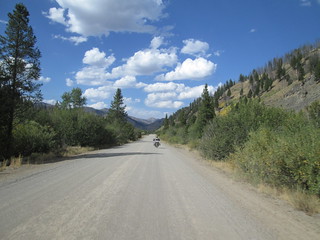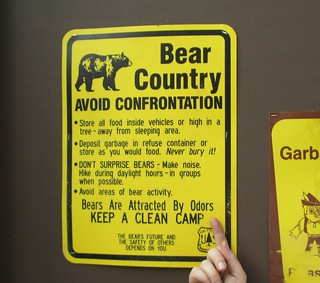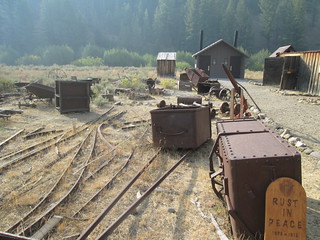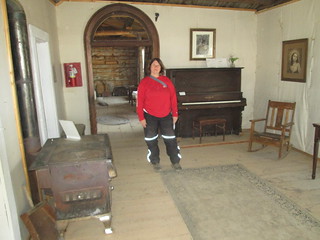Part 4: Historic Custer, Idaho
Part of our two week motorcycle
adventure in Idaho (mostly)
September 2016
DRAFT
Introduction and Part 1: Hell's Canyon drive from
Oxbow Bridge along the Snake River to the Hell's Canyon dam and then back
over Oxbow dam to Cambridge, Idaho, and everything up to Part 2
Part 2: Historic Silver City, Idaho
Part 3: Bruneau Dunes State Park, City of Rocks
National Reserve, Sawtooth Scenic Byway, Sun Valley and Ketchum
Thursday, Day 6
We were now in the Salmon-Challis
National Forest in Idaho, headed to Sunbeam and the turnoff for
historic Custer ghost town. The turnoff for Custer is about 13 miles North
of Stanley on state road 75. We passed the historic Sunbeam bathhouse, next
to the Salmon river. We didn't stop, but we did slow down, just so I could
point out that, mensch, it was stinky! Apparently, there are user-built hot
spring pools down by the river that are exposed in Summer and submerged in
the river at other times. Then we came to Sunbeam and the sudden turnoff
onto Yankee Fork Road in a road curve. It is a HUGE mistake on the part of
the state that there is no sign on the highway for Custer. It deserves such.
Are you listening, Idaho
State Historical Society or Visit
Idaho? We never would have known it was there had it not been for
meeting that other biker earlier.
 After
the turnoff for Custer, there are two or three national forest campgrounds
on the way to the historic mining town, and they looked mostly empty. It's
just 10 miles from state road 75 to Custer, and while most of it is gravel,
it's the easiest gravel you will ever do. The wide, well-packed road is atop
the rocks dredged out of and along the Yankee Fork river by gold mining
companies and is quite straight. There were a lot of people camping rough
just off the road - we guessed the campers we saw, all in large RVs, were
hunters and fishermen. We passed a
sign for Bonanza City and passed the Historic
Yankee Fort Gold Dredge, intending to visit both the next day. It was
nearing 5 p.m., and we wanted to get to Custer before then, in case the
information office there closed at 5.
After
the turnoff for Custer, there are two or three national forest campgrounds
on the way to the historic mining town, and they looked mostly empty. It's
just 10 miles from state road 75 to Custer, and while most of it is gravel,
it's the easiest gravel you will ever do. The wide, well-packed road is atop
the rocks dredged out of and along the Yankee Fork river by gold mining
companies and is quite straight. There were a lot of people camping rough
just off the road - we guessed the campers we saw, all in large RVs, were
hunters and fishermen. We passed a
sign for Bonanza City and passed the Historic
Yankee Fort Gold Dredge, intending to visit both the next day. It was
nearing 5 p.m., and we wanted to get to Custer before then, in case the
information office there closed at 5.
We pulled into Custer and I was immediately delighted. It has far fewer
buildings than Bodie, California or Silver City,
Idaho, but still has lots to see. We parked and walked into the little
one-room museum, which used to be the town's school house. It was still
open, and the man working the front desk was enthusiastic to answer any
questions we might have. We had a look at the items on display. I was
pleased to see the Chinese contributions to the area so well acknowledged in
the museum.
There was a national forest ranger leaving the Empire Saloon across the
street - it's no longer a saloon but, rather, a gift shop and place to buy
soft drinks. She confirmed what Brian had told us, that there was a
campground beyond the town, Custer #1. "And the bathroom is clean, because I
cleaned it this morning!" We pushed on, and the
road was a little more complicated, then a little more
complicated: not as well packed, narrower, and some elevation changes, but
still manageable. We passed the Custer
graveyard, intending to visit the next day. Right after the sign for
Slaughterhouse Gulch, on a curve, on the left, was the entry for Custer
#1 campsite, and it, the road got significantly steeper, so I whipped
into the campground, making the complicated left turn on a hill better than
I would have if I'd been able to think about it. Turning into an actual camp
site proved more complicated, so I stopped on the campsite road and waited
for Stefan to pick a site, park, and then come back and park my bike for me.
Yeah, I know, some of you are rolling your eyes. You know what? Screw you.
Years ago, when I was just getting started with motorcycle travel, a woman
motorcyclist in a parking lot in Jordan Valley told me never to be ashamed
of asking someone to help me park, get started, etc., because sometimes,
some people need help, and that's that. And 30 minutes later, in that very
same parking lot, Stefan and I were helping a guy on his way to Alaska put
his way-too-over-packed bike upright from the kickstand, because he couldn't
do it himself.
Of course, I found out later the campsite road is a loop, and I could have
just continued on, turned around, and slipped right into our campsite... and
our
campsite was, we think, the very same one Brian stayed in the night
before - it still had a booking slip on the campsite sign. I thought I
smelled smoke, but we didn't see anything. What we did see: bees. They were
everywhere. They were all over our motorcycles, and all around us because we
were eating - eating some of the delicious homegrown tomatoes we'd brought
from home. We had to hang our trash up on a nail (already in a tree!) well
away from the picnic table, because the bees just would not go away. I
proposed we stay at the campsite two nights, and see all that there was to
see in the area, but after studying the maps and what we wanted to do, we
realized it wasn't possible. I realized that we were never going to get to
stay two nights somewhere, and that was disappointing, because that one day
off of riding, of just being in one place and not having to put the tent up
and set up camp, is awesome, like a vacation from our vacation.
 It
cooled off, the bees disappeared at last, and we realized we were probably
going to be alone in the campground that night. We put all food, the trash
and my toiletry bag in our panniers, and the big food and fuel bag in the
pit toilet, because there was a bears-in-the-area sign on a message board in
the campground. I went to bed and Stefan stood outside smoking after
nightfall, and he said, "I see three sets of glowing eyes staring at me down
by the bathroom." Gulp. He'd heard the critters up on a hill next to the
road, and now they were looking back at him - he had a headlamp on. He said
all were low to the ground. Coyotes? Racoons? I said, "Talk loudly and tell
them to go away. Make a big strong move towards them." He did. They didn't
move. Gulp. Then they finally padded off. Yeah, going to the bathroom in the
middle of the night that night was a TERRIFIC experience...
It
cooled off, the bees disappeared at last, and we realized we were probably
going to be alone in the campground that night. We put all food, the trash
and my toiletry bag in our panniers, and the big food and fuel bag in the
pit toilet, because there was a bears-in-the-area sign on a message board in
the campground. I went to bed and Stefan stood outside smoking after
nightfall, and he said, "I see three sets of glowing eyes staring at me down
by the bathroom." Gulp. He'd heard the critters up on a hill next to the
road, and now they were looking back at him - he had a headlamp on. He said
all were low to the ground. Coyotes? Racoons? I said, "Talk loudly and tell
them to go away. Make a big strong move towards them." He did. They didn't
move. Gulp. Then they finally padded off. Yeah, going to the bathroom in the
middle of the night that night was a TERRIFIC experience...
Friday, Day 7
We got up super early the next day - to a very smokey landscape. Remember
how I smelled smoke the night before? We were nervous - was the fire just on
the other side of the hill? We ate breakfast, enjoying more of our delicious
homegrown tomatoes, but nervously watching all the high horizons. The forest
ranger knew we were there, so if we needed to evacuate, we expected someone
would have already been there to tell us to get out. The smoke never got
worse, so while we didn't dawdle, we didn't rush.
There was no signs of coyotes or raccoons, that we could find, but a dear or
elk definitely came through and checked out the picnic table. We were out of
the campsite by 9:30 a.m. Mountain time, the earliest we'd ever pushed off.
We stopped at the Custer cemetery. Cemeteries don't make me sad, just
introspective. I ponder... it's not a very big cemetery, because most people
were buried in Bonanza City. The
most interesting grave is Colonel Sprague's. Further down the road is
a
ranch that seems to have buildings from the Custer era, but we
surmised that it was private property, so we didn't trespass. A shame the
smoke ruined any chance of getting a good photo of the old mining structure
on the side of the a hill on the way down.
 We
arrived in Custer and weren't the first tourists there for the day, which
was a shock. All of the buildings were already open and ready for visitors.
There were far more buildings open for tours than I expected. Like Bodie, Custer
has lots of items scattered around the site, inside buildings and outside,
rusting. Plenty of stoves
- always my favorite. Lots of mining equipment, fire
fighting equipment, old sewing machines (like this
one that looks like the one my great-grandmother, Mama Susie, had), an
old
bathtub, and
on and on. There are also information boards all around, providing
some interesting
stories about the former residents.
We
arrived in Custer and weren't the first tourists there for the day, which
was a shock. All of the buildings were already open and ready for visitors.
There were far more buildings open for tours than I expected. Like Bodie, Custer
has lots of items scattered around the site, inside buildings and outside,
rusting. Plenty of stoves
- always my favorite. Lots of mining equipment, fire
fighting equipment, old sewing machines (like this
one that looks like the one my great-grandmother, Mama Susie, had), an
old
bathtub, and
on and on. There are also information boards all around, providing
some interesting
stories about the former residents.
Some
of the photos we took have a mystical feel because of the smoke in the air,
which we learned was from a fire quite far away.
Custer was founded in early 1879 by gold speculators. Custer's Chinatown,
with about thirty residents, was situated right below the lower end of
Custer. The town reached its peak population of 600 in 1896. In its heyday,
the town boasted a post office, a school, a general store, a boarding house,
the Nevada House Hotel, restaurants and saloons. However, it never had a
church, something I find amazing. Another park ranger told us that there was
a secret speakeasy behind one of the buildings. In a town like this, isn't
that a shed with some crates to sit on and a still? By 1910, there were only
about 12 families living in Custer, and when the Sunbeam Mine closed in
April 1911, Custer quickly became a ghost town. It's been lovingly restored
by the Yankee Fork Historical Association, the Idaho Department of Parks and
Recreation and the Salmon-Challis National Forest.
One of my favorite stories about Custer is about Louise Treloar Short, who
grew up in North Carolina from a well-to-do-family. At age 30, unmarried,
she traveled to join her brothers who worked in Bayhorse, Idaho. There, she
met a man and moved with him to Custer. He left her in poverty, and she
lived along in a tiny, one-room stone house on a hill above the city - the
remains of the house are still there. Another story is the most famous story
from the town, about three little girls killed in an avalanche in their
home. The three are buried in the town instead of Bonanza, right
behind the school house. There's another story, about a woman married
multiple times, who was murdered in the town - the storyboard is in the
saloon/gift shop, but I forgot to take a photo of it.
By the way: here's
my favorite stove. I love old stoves.
 I
wasn't
dressed appropriately for the parlor in the nicest house in town. And
note that, indeed, there is a STOVE in this photo. I think I took photos of
six stoves in the town.
I
wasn't
dressed appropriately for the parlor in the nicest house in town. And
note that, indeed, there is a STOVE in this photo. I think I took photos of
six stoves in the town.
It was a terrific visit. Why do I love visiting historic towns in the
American West? It's hard to say. Sure, they aren't as old or historic as
historic towns in, say, Europe. But there is something about being a little
closer to the past history of my country, seeing cans and bottles and tools
I saw in my great-grandparents' houses, thinking about the massive changes
in human lives in just 100 - 150 years... it really moves me. I also
love the simplicity and practicality in architecture and tools. I like the
thought of valuing live music and good food and visits with friends that
people had then - and rarely have now. I don't romanticize the lives or the
people: they lived hard, most people died young, many were riddled with
physical problems their entire lives, and they were as cruel as they were
noble. And, yet... it makes me just a little dreamy.
Where would I put this in the ranks of "ghost towns"/historic mining
towns/pre-1900s towns in the USA I've visited? Bodie,
Calfornia remains number 1 - there's just SO much to see, its history
is oh-so-interesting, and the landscape is incredible. Silver
City, Idaho is now in the number 2 spot. Custer, Idaho is tied with
Garnet, Montana for me at number 3 - and interesting note, the volunteers we
met staffing things in Custer are related to the family that used to own
Garnet. If I could explore Nevada City, Montana more, it might move up in
the rankings. I think Berlin, Nevada is worth visiting - there's not a great
deal there, but there's enough to be interesting, the surroundings give you
a real feeling of the loneliness of a Gold Rush miner's life, and the Berlin-Ichthyosaur
State Park exhibit of Ichthyosaur bones is right next door. Columbia,
California is worth visiting, but it's just a bit too touristy for me -
though all the restaurants and services and shops and kitsch is just what
other tourists are looking for, so, no criticism on that count - and I did
enjoy my visit there.
On the way out of Custer, the same way we came in, we stopped at the Historic
Yankee Fort Gold Dredge, for photos outside. We'd decided not to stop
inside after all. Here's the official
web site for the historic dredge. We headed on to Bonanza City, but at
the cemetery, the ground turned to powder dirt, something I cannot
ride on. I parked and toured the cemetery while Stefan pushed on to see if
there was much to see in Bonanza City. If there was, he never found it, just
a
nice view from the road.
However, we could have left and headed to Challis by going back on the road
we took to Custer #1 campground, past the Custer cematery: this is the
46-mile dirt and gravel Custer Motorway that follows the route of the
original 1879 toll road that lead to Custer from Challis. You can call the
Land of the Yankee Fork Visitor Center for current status of the road (snow,
or no?). It is not recommended for low clearance vehicles or trailers. I
refused to go on it because the incline just past the campground was SUPER
steep, and I couldn't imagine going on a a 46 mile road like that on a fully
loaded-down bike, even a KLR, at least not at my skill level.
We headed back out to paved State Road 75, heading to Challis.
More in Part 5:
- Ft. Missoula, Montana
- Wallace, Idaho
- Lake Coeur d'Alene, Idaho
- White Pine Scenic Byway, Idaho
- Hell's Canyon Overlook, Oregon
- Joseph, Oregon
- Painted Hills, Oregon
- Little Crater Lake, Oregon
Know when I travel by:
Following me me at My @jayne_a_broad
Twitter feed 
This Twitter feed is focused on my experiences traveling, camping, riding
my motorcycle or my bicycle, taking mass transit (buses and trains),
commuting by walking or bicycling, and various other mostly-personal
interests.
Liking my Jayne A Broad
Facebook page 
This Facebook fan page is where I follow USA state parks, national parks,
national forests, and organizations focused on sustainable tourism, getting
children, women and under-represented groups outdoors, and related
international organizations and sites. My travel-related tweets from the my
jayne_a_broad twitter feed (see below) get posted here automatically.
Return to the broads abroad home page
Disclaimer
Any activity incurs risk. The author assumes no responsibility for the use
of information contained within this document.
A Broad Abroad | contact me
The content of this page is by
by Jayne Cravens, 2006-2016, all rights reserved
 After
the turnoff for Custer, there are two or three national forest campgrounds
on the way to the historic mining town, and they looked mostly empty. It's
just 10 miles from state road 75 to Custer, and while most of it is gravel,
it's the easiest gravel you will ever do. The wide, well-packed road is atop
the rocks dredged out of and along the Yankee Fork river by gold mining
companies and is quite straight. There were a lot of people camping rough
just off the road - we guessed the campers we saw, all in large RVs, were
hunters and fishermen. We passed a
sign for Bonanza City and passed the Historic
Yankee Fort Gold Dredge, intending to visit both the next day. It was
nearing 5 p.m., and we wanted to get to Custer before then, in case the
information office there closed at 5.
After
the turnoff for Custer, there are two or three national forest campgrounds
on the way to the historic mining town, and they looked mostly empty. It's
just 10 miles from state road 75 to Custer, and while most of it is gravel,
it's the easiest gravel you will ever do. The wide, well-packed road is atop
the rocks dredged out of and along the Yankee Fork river by gold mining
companies and is quite straight. There were a lot of people camping rough
just off the road - we guessed the campers we saw, all in large RVs, were
hunters and fishermen. We passed a
sign for Bonanza City and passed the Historic
Yankee Fort Gold Dredge, intending to visit both the next day. It was
nearing 5 p.m., and we wanted to get to Custer before then, in case the
information office there closed at 5.  It
cooled off, the bees disappeared at last, and we realized we were probably
going to be alone in the campground that night. We put all food, the trash
and my toiletry bag in our panniers, and the big food and fuel bag in the
pit toilet, because there was a bears-in-the-area sign on a message board in
the campground. I went to bed and Stefan stood outside smoking after
nightfall, and he said, "I see three sets of glowing eyes staring at me down
by the bathroom." Gulp. He'd heard the critters up on a hill next to the
road, and now they were looking back at him - he had a headlamp on. He said
all were low to the ground. Coyotes? Racoons? I said, "Talk loudly and tell
them to go away. Make a big strong move towards them." He did. They didn't
move. Gulp. Then they finally padded off. Yeah, going to the bathroom in the
middle of the night that night was a TERRIFIC experience...
It
cooled off, the bees disappeared at last, and we realized we were probably
going to be alone in the campground that night. We put all food, the trash
and my toiletry bag in our panniers, and the big food and fuel bag in the
pit toilet, because there was a bears-in-the-area sign on a message board in
the campground. I went to bed and Stefan stood outside smoking after
nightfall, and he said, "I see three sets of glowing eyes staring at me down
by the bathroom." Gulp. He'd heard the critters up on a hill next to the
road, and now they were looking back at him - he had a headlamp on. He said
all were low to the ground. Coyotes? Racoons? I said, "Talk loudly and tell
them to go away. Make a big strong move towards them." He did. They didn't
move. Gulp. Then they finally padded off. Yeah, going to the bathroom in the
middle of the night that night was a TERRIFIC experience...  We
arrived in Custer and weren't the first tourists there for the day, which
was a shock. All of the buildings were already open and ready for visitors.
There were far more buildings open for tours than I expected. Like Bodie, Custer
has lots of items scattered around the site, inside buildings and outside,
rusting. Plenty of stoves
- always my favorite. Lots of mining equipment, fire
fighting equipment, old sewing machines (like this
one that looks like the one my great-grandmother, Mama Susie, had), an
old
bathtub, and
on and on. There are also information boards all around, providing
some interesting
stories about the former residents.
We
arrived in Custer and weren't the first tourists there for the day, which
was a shock. All of the buildings were already open and ready for visitors.
There were far more buildings open for tours than I expected. Like Bodie, Custer
has lots of items scattered around the site, inside buildings and outside,
rusting. Plenty of stoves
- always my favorite. Lots of mining equipment, fire
fighting equipment, old sewing machines (like this
one that looks like the one my great-grandmother, Mama Susie, had), an
old
bathtub, and
on and on. There are also information boards all around, providing
some interesting
stories about the former residents.  I
wasn't
dressed appropriately for the parlor in the nicest house in town. And
note that, indeed, there is a STOVE in this photo. I think I took photos of
six stoves in the town.
I
wasn't
dressed appropriately for the parlor in the nicest house in town. And
note that, indeed, there is a STOVE in this photo. I think I took photos of
six stoves in the town. ![]()